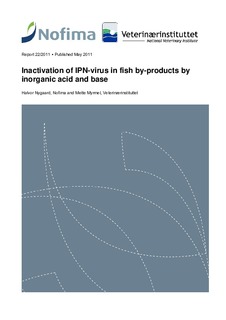| dc.description.abstract | The aim of the project was to find a simple, inexpensive and safe method for the treatment of category 2 fish by-products without heat treatment. IPNV was chosen as indicator organism because it was considered to be the hardiest among fish-pathogenic microorganisms. Salmonella and Clostridium perfringens were included in the study to provide a basis for assessing whether the method could also be applicable to category 3 by-products intended for feed production. IPNV was inactivated (> 4 Log10 reductions) at pH below 1,5 or above 11,5. Depending on the composition of the by-products, this corresponds to dosage of 1,0-1,8 % HCl or 0,9-2,0 % KOH. Salmonella was inactivated at pH between 3,0 and 4,0 or above 11,0. This corresponds to less than 1,0 % HCl, or, depending on the composition of the by-products, 0,7-1,7 % KOH. Salmonella is therefore securely inactivated at conditions required to control IPNV. HCl treatment for 5 hours at pH 1,0 gave 1 Log10 reduction of viable C.perfringens spores. No inactivation was observed at high pH values, up to 12,0. The pH conditions required to control IPNV does not affect the viability of C.perfringens spores. The present study shows that the required inactivation of IPNV in fish by-products can be achieved by treatment with both inorganic acid and base. The effect of these treatments on processability and as product properties in relation to intended utilizations should be further examined. | |
